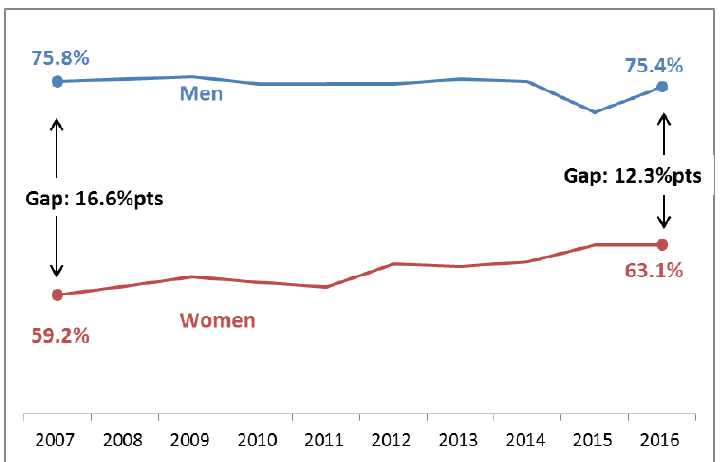5. Motor Vehicles, Traffic and Driving
26 September 2017 - Transport and Travel in Scotland 2016
5. Motor Vehicles, Traffic and Driving
This section contains analysis and headline findings from the Scottish Household Survey questions on driving and car access (including the Travel Diary part of the survey), as well as comparisons with data from a range of other sources.
Driving Licences
Sixty nine per cent of the population (17+) had a driving licence in 2016, a slight increase compared to sixty eight per cent in 2015. [Table SUM1 and Table 1]
Three quarters (75%) of men aged 17+ had a driving licence, compared to 63 per cent of women. There has been a narrowing of this gap over the years of the survey. [Table 1 and Figure 1]
Figure 1: Driving licence possession by gender

Driving licence possession was lowest amongst younger and older people (17-19: 30% and 80+: 43%) and highest amongst those aged 40-49 (81%). [Table 1]
Driving licence possession increased with net annual household income (46% for adults in households with less than £10,000 of income compared to 89% in households with an income over £40,000). [Table 19]
Driving licence possession is more common in rural areas (62% of adults in large urban areas have a driving licence, compared to 82% of those in remote rural areas). [Table 19]
Car and Van Access
Seventy one per cent of households had access to one or more cars or vans for private use in 2016. Twenty nine per cent of households had access to two or more cars (or vans). [Tables 18 & SUM1]
Car access increases with household income, as does the number of cars available per household: seven per cent of households with an annual income up to £10,000 had access to two or more cars, compared to sixty nine per cent of households with an annual income of more than £40,000. [Table 18]
Households in rural areas were more likely to have access to a car than those in urban areas, and households in rural areas were also more likely to have access to more than one car than households in urban areas. [Table 18]
Frequency Of Driving
Sixty nine per cent of those aged 17+ drove at least once a week in 2016, with 42 per cent driving every day. [Tables 20 & SUM1]
Frequency of driving increased with income and with rurality. Thirty five per cent of adults in large urban areas drove every day compared to forty nine per cent of adults in remote rural areas. Twenty per cent of adults living in households with a total annual income of under £10,000 drove every day, compared to sixty three per cent of those who lived in households with a total annual income of over £40,000. [Table 20]
Car Occupancy
The average car occupancy was 1.5 people in 2016; the rate has remained similar in recent years. The proportion of single occupancy journeys has seen increases in recent years and accounted for around two thirds (67%) of car journeys in 2016, an increase from 62% in 2007. [Table TD9]
Fuel Spend
The average amount which households spent on fuel in the last month fell slightly between 2015 and 2016, from £109.20 to £105.60. The median figure, however, remains at £80. [Table 2]
Licensed Vehicles
There were 270,000 new vehicles registered in Scotland in 2016, the highest number of new registrations since 2007. [Table SUM2]
The number of vehicles licensed for use on the roads increased by 1.5 per cent from 2.82 million to 2.86 million between 2014 and 2015. [Table SUM2]
More detailed statistics on vehicles licensed in Scotland can be found in the Road Transport Vehicles Chapter of Scottish Transport Statistics.
Road Network
There are 56,092 kms of road in Scotland. Of this, 6.4 per cent (3,578 km) is Trunk road, the remaining 52,514 km are managed by Local Authorities. [Table SUM2]
More detailed statistics on the road network in Scotland can be found in the Road Network chapter of Scottish Transport Statistics.
Road Traffic
The estimated volume of traffic on Scotland’s roads was at its highest ever - 45.4 billion vehicle kilometres in 2015, an increase on 2014 and slightly above the previous recent peak in 2007 of 44.7 billion. [Table SUM2] More detailed statistics on road traffic in Scotland can be found in the Road Traffic chapter of Scottish Transport Statistics.
Reported Road Casualties
Provisional figures show a total of 8,346 road accidents reported to the police in 2016 (2%, fewer than in 2015), the lowest figure since records began in 1950. Of these, there were 175 fatal accidents; 18 (11%) more than in 2015. There were 1,428 serious injury accidents; 8 (or 1%) more than in 2015 and 6,743 accidents resulting in slight injury: 160 (or 2%) fewer than in 2015. More detailed statistics can be found in Key Reported Road Casualties.
Electric Vehicles
In 2016, the Scottish Household Survey contained a number of new questions on plug-in electric cars or vehicles. Thirty six per cent of respondents said they would consider buying an electric car or van; forty nine per cent said they would not. Less than one per cent of respondents said they already owned an electric car or van. [Table 49]
Of the people who had bought or would consider buying a plug-in electric car or vehicle, the main reason was that these vehicles are environmentally friendly (68%) and fuel or running costs (64%). [Table 50] For those who said they would not consider buying an electric vehicle, the distance travelled on a single charge (46%) and the availability or convenience of charging points (also 46%) were the main deterrents. [Table 51]